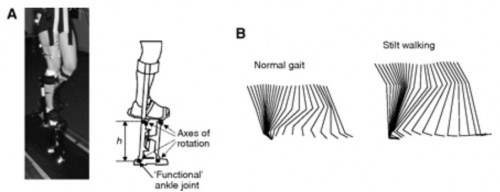Should shorter legs take quicker strides?
The optimal running cadence does depend on leg length -- but not exactly how you might expect.
Okay, this is something I never expected to see: a study that uses walking on stilts to investigate the effect of limb length on optimal stride! First, let me backtrack. A few weeks ago, we had a spirited discussion on the blog about optimal running cadence, and one of the questions that came up was what role, if any, leg length should play in your cadence. Should Haile Gebrselassie (5’4″) and Paul Tergat (6’0″) run with exactly the same stride length?
Enter Max Donelan, the head of the Locomotion Laboratory at Simon Fraser University. He sent me an e-mail explaining that, all else being equal, running cadence (a.k.a. stride frequency) should be inversely proportional the square root of leg length. I’m going to quote the relevant section of the e-mail here, because he explains it well:
Some of your commenters were wondering about differences in size. Biomechanics knows how to normalize for size and we learned how from physicists – we use dimensional analysis and dynamic similarity. While there is some complexity for running, the same relative speed works out to be speed/sqrt(gravity*leg length). This is called the “Froude number”. Relative frequency scales with freq/sqrt(gravity/leg length). And, we expect that at the same relative speed, animals will use the same relative frequency. This turns out to be approximately true in animals ranging from mice to elephants. This matters for your article in two ways. First, it indeed says that smaller people should use a higher frequency at the same speed (although it is proportional to sqrt(leg length) and not directly proportional to leg length which is not intuitive for people). The second reason it is important is that we expect people that are approximately the same size, and running at approximately the same speed, to use approximately the same frequency. That is an explanation for why the best marathon runners use the same step frequency – they are all pretty physically similar and all running at about the same speed. If you can find a very tall winner and a very short winner, I bet one Canadian looney that their step frequencies are quite different.
Fascinating stuff. So of course, I looked up a few papers on the Froude number as it applies in running and walking (and there are, indeed, lots of them). One of them was the stilts paper, published a few months ago in the Journal of Experimental Biology.

Basically, they strapped on stilts to change the ratio of upper length to lower length, then measured oxygen consumption and muscle activation. Sure enough, limb segment ratio does make a difference in optimal speed and frequency — not that surprising, really. The more important message (for me, anyway) is that there’s a big body of literature supporting this idea that the Froude number applies to both walking and running, and thus that taller people should (if all else is equal) have a slower cadence than shorter people, by an amount inversely proportion to the square of leg length.
Oh, and one last point. Max wrote:
If you can find a very tall winner and a very short winner, I bet one Canadian looney that their step frequencies are quite different.
Here’s video of the classic example I cited before: Geb vs. Tergat in the last lap of the 2000 Olympics, running at the same speed but with different cadences. They start out striding in synch, but Geb is (as expected) striding more quickly. At a very, very rough estimate, it looks like it takes about 15 steps before they lock into synch again, which would imply that Tergat’s legs are about (16/15)^2 -> 14% longer than Geb’s. Considering that he’s 12.5% taller, that’s not a bad appromixation!
[Many thanks to Max Donelan for sharing his expertise!]


